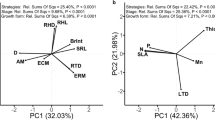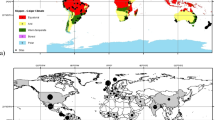Summary
Recent discussions on determinants of competitive success during succession require the study of the combined effect of light and nutrient availability on growth and allocation. These effects can be used to predict the outcome of competition at changing resource availabilities. This work is part of a study on the successional sequence in permanent grassland starting after fertilizer application is stopped, but with continued mowing, in order to restore former species-rich communities. This yields a successional sequence which proceeds from grasslands with a high nutrient availability and a closed canopy, to grasslands with a low nutrient availability and an open canopy. If allocation is related to competitive ability, species from the productive stages would be expected to allocate more biomass and nitrogen to leaves, which could make them better competitors for light, while species from the unproductive stages would allocate more biomass to roots, which could make them better nutrient competitors. This study reports on growth, specific leaf area (SLA), vertical display of leaves, and allocation of biomass and nitrogen of six grassland species from this successional sequence at 16 combinations of light and nutrient supply. Species from the poorer successional stages reached a lower final dry weight than species from the richer stages, over all treatment combinations. The experimental design made it possible to test for unique effects of the resource ratio effect of light and nutrients on allocation characteristics. This resource-ratio effect was defined as the ratio light intensity/(light intensity + nutrient supply rate), using standardized levels for the treatments. The within-species variation (plasticity) in both allocation of dry matter and nitrogen was linearly related to this resource-ratio effect. Some interspecific differences in this relationship were found which could be related to the position of the species along the successional gradient. However, the range of plasticity in allocation pattern expressed within each species was much larger than the differences between species. It was concluded that allocation differences between these grassland species are relatively unimportant, given the large amount of plasticity in these traits. Interspecific differences in SLA and vertical stature seemed to be more important in explaining the position of species along the successional gradient.
Similar content being viewed by others
References
Aerts R (1989) Nitrogen use efficiency in relation to nitrogen availability and plant community composition. In: Lambers H et al. (eds) Causes and consequences of variation in growth rate and productivity of higher plants. SPB Academic, The Hague, The Netherlands, pp 285–297
Bakker JP (1989) Nature management by cutting and grazing. Junk, Dordrecht, The Netherlands
Berendse F (1985) The effect of grazing on the outcome of competition between plants with different nutrient requirements. Oikos 44:35–39
Berendse F, Aerts R (1987) Nitrogen-use-efficiency: a biological meaningful definition? Funct Ecol 1:293–296
Berendse F, Elberse WTh (1989) Competition and nutrient losses from the plant. In: Lambers H et al. (eds) Causes and consequences of variation in growth rate and productivity of higher plants. SPB Academic, The Hague, The Netherlands, pp 26–284
Berendse F, Oudhof H, Bol J (1987) A comparative study on nutrient cycling in wet heathland ecosystems. 1. Litter production and nutrient loss from the plant. Oecologia 74:174–184
Bobbink R, Bik L, Willems JH (1988) Effects of nitrogen fertilization on vegetation structure and dominance of Brachypodium pinnatum L. Beauv in chalk grassland. Acta Bot Neerl 37:231–242
Brouwer R (1963) Some aspects of the equilibrium between overground and underground parts. Jaarb IBS 213:31–39
Campbell BD, Grime JP (1989) A comparative study of plant responsiveness to the duration of episodes of mineral nutrient enrichment. New Phytol 112:261–267
Chapin FS (1980) The mineral nutrition of wild plants. Annu Rev Ecol Syst 11:233–260
Davidson RL (1969) Effects of soil nutrients and moisture on root/shoot ratios in Lolium perenne L. and Trifolium repens L. Ann Bot 33:571–577
Givnish TJ (1988) Adaptation to sun and shade: a whole plant perspective. Aust J Plant Physiol 15:63–92
Grime JP (1979) Plant strategies and vegetation processes. Wiley & Sons, Chichester
Grime JP, Hunt R (1975) Relative growth rate: its range and adaptive significance in a local flora. J Ecol 63:393–422
Grime JP, Crick JC, Rincon JE (1986) The ecological significance of plasticity. J Exp Biol 126:5–29
Grime JP, Campbell BD, Mackey JML, Crick JC (1989) Root plasticity, nitrogen capture and competitive ability. In: Atkinson D (ed) Plant root systems: their effect on ecosystem composition and structure. Blackwell, Oxford
Klinkhamer PGL, de Jong TJ, Meelis E (1990) How to test for proportionality in the reproductive effort of plants. Am Nat 135:291–300
Olff H, Bakker JP (1991) Long term dynamics of standing crop, vegetation composition and species richness after the cessation of fertilizer application to hay-fields. J Appl Ecol (in press)
Olff H, Van Andel J, Bakker JP (1990) Biomass and shoot:root allocation of five species from a grassland succession series at different combinations of light and nutrient supply. Funct Ecol 4:193–200
Pegtel DM (1987) Soil fertility and the composition of semi-natural grassland. In: Van Andel J, Bakker JP, Snaydon RW (eds) Disturbance in Grasslands. Junk, Dordrecht, The Netherlands, pp 51–66
Poorter H (1989) Interspecific variation in growth rate: on ecological causes and physiological consequences. In: Lambers H et al. (eds) Causes and consequences of variation in growth rate and productivity of higher plants. SPB Academic, The Hague, The Netherlands, pp 45–68
Poorter H, Remkes C, Lambers H (1990) Carbon and nitrogen economy of 24 wild species differing in relative growth rate. Plant Physiol 94:612–627
Rice SA, Bazzaz FA (1989) Growth consequences of plasticity of plant traits in response to light conditions. Oecologia 78:508–512
Tilman D (1985) The resource-ratio hypothesis of plant succession. Am Nat 125:827–852
Tilman D (1988) Plant strategies and the dynamics and structure of plant communities. Princeton University Press, Princeton
Author information
Authors and Affiliations
Rights and permissions
About this article
Cite this article
Olff, H. Effects of light and nutrient availability on dry matter and N allocation in six successional grassland species. Oecologia 89, 412–421 (1992). https://doi.org/10.1007/BF00317420
Received:
Accepted:
Issue Date:
DOI: https://doi.org/10.1007/BF00317420




